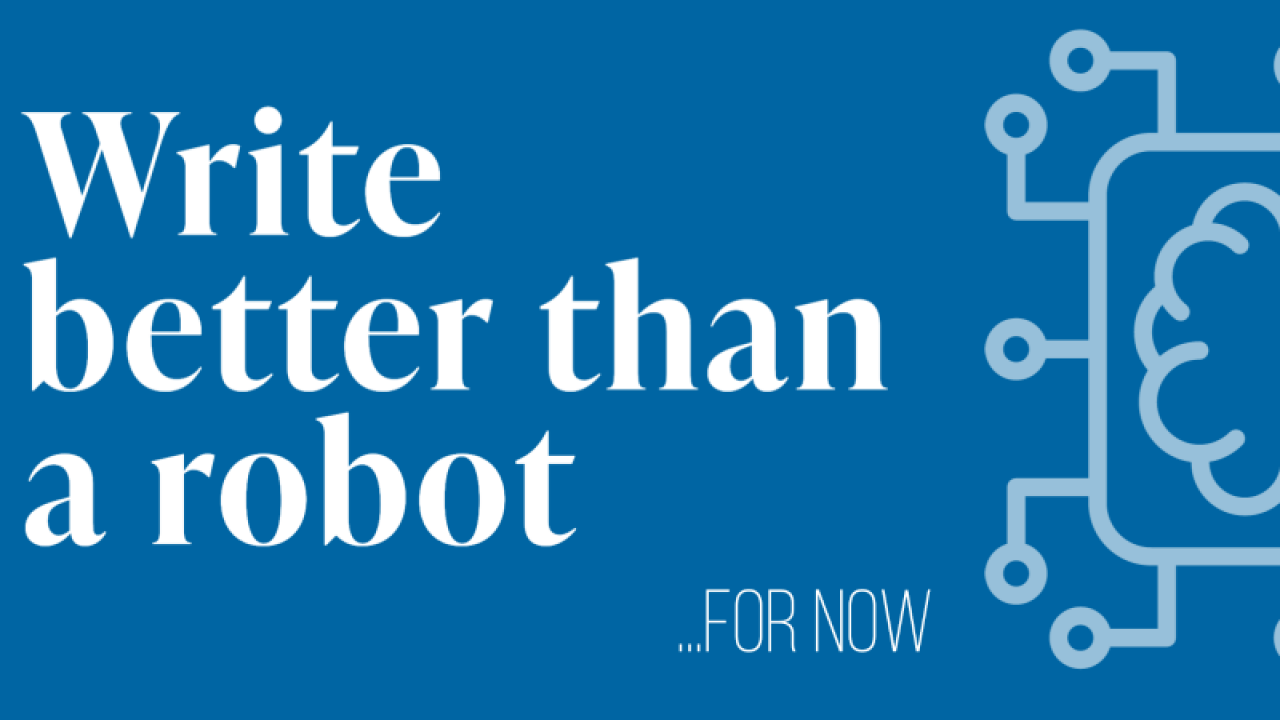April 26, 2023
Write better than a robot: Introducing my PR class to ChatGPT

Editor's Note: Special thanks to Joseph Niedziejko for helping with this project.
I recently attended the Institute for Public Relations Bridge Conference where practitioners and professors were mostly talking artificial intelligence. It struck me that practitioners were saying that they anticipate that new graduates will be very adept and interested in using AI, and they were looking at these digital natives to help sort out how AI can impact their work.
In my limited, informal classroom research (show of hands), I knew that this digital native assumption was off the mark. Less than 10 percent of my students this semester said they’ve already used ChatGPT.
“Write Better Than a Robot” was quickly fast tracked as an in-class activity, and I knew just the person to co-teach it with me. Joseph “Joey” Niedziejko is a senior account executive at Maven Communications and had recently posted a blog about using ChatGPT in public relations. We kept the activity simple.
1. Get up to speed
Background reading was assigned.
2. Get real
Joey presented tangible examples of how he’s used ChatGPT in his day-to-day client-based work at Maven. He showed how he used it to build a media list, generate a Tweet for a client, and how to write a pitch letter. He discussed best practices for writing a prompt and the pitfalls to look out for when reviewing results.
3. Get schooled
I reviewed best practices of media relations (from the course content we’ve been studying) that I would expect from the tasks I was asking them to perform which included creating a media list, Tweet pitch letter.
4. Get your hands dirty
Students were asked to sign up for ChatGPT in advance of the class. They logged in and were tasked with finding journalists who cover a certain topic, writing a Tweet with certain attributes, and developing a pitch letter. They used their final project topics.
5. Get reflective
As a class, we reflected on whether the results met the expectations of best practices in media relations. The results were mixed. The students found some faults and some benefits. The media lists were good. The students had already pulled media lists using their media database (MuckRack), so they were able to compare results. Some of the Tweets were good, too, although here the students felt the tone or the call to action was off. The pitch letters varied between okay and bad. Many did not follow best practices that we emphasize in class. The tone was often off and students agreed that the voice was…well…”robotic”! They also found irrelevancy in facts, not misinformation per se, but the wrong facts for the situation.
6. Get philosophical
Joey and I discussed ethical considerations of using AI. We referenced examples of organizational missteps and inherent flaws in AI when it comes to bias.
In short, the class agreed that they viewed ChatGPT as a “shortcut” tool that could jumpstart their research but not replace their work. The review and editing process was still an integral part of the process so they left confident that they can “Write Better Than a Robot”
….at least for now!
Assigned reading
► (AI and Communications Professionals) Prompts for communicators using the new AI-powered Bing
► (Legal Implications | Art) Coke asks consumers to generate art with new AI platform
► (Misinformation) Learning to lie: AI tools adept at creating disinformation
Activity prompts
Students were asked to use their final project as the subject for their AI activity. They have a nationally known association as their client. They are tasked with finding an active piece of legislation that their association would be interested in advocating for (or against). The final project has them create a media strategy that involves building a media list, developing key messages, and using both social media and traditional media to connect with their stakeholders. They were asked to use ChatGPT to:
► Find 10 journalists who regularly cover their topic.
► Write a Tweet from their association that announces their client’s position on the legislation.
► Write a pitch letter to a reporter who is covering the current legislation offering a renowned expert from their association who can talk about the topic and the bill.
The students were given a lot of leeway to write the prompts based on the unique needs and circumstances of their client. They were challenged to refine prompts.
► Do you want US only journalists? Regional media? How do you write the prompt to reflect what you know about the media strategy you want to pursue?
► How do you ask ChatGPT to create a Tweet using a certain tone?
Ethical examples referenced
KFC apologises after German Kristallnacht promotion
Vanderbilt University apologizes for using ChatGPT
How AI and new technologies reinforce systematic racism
Microsoft lays off its AI team
